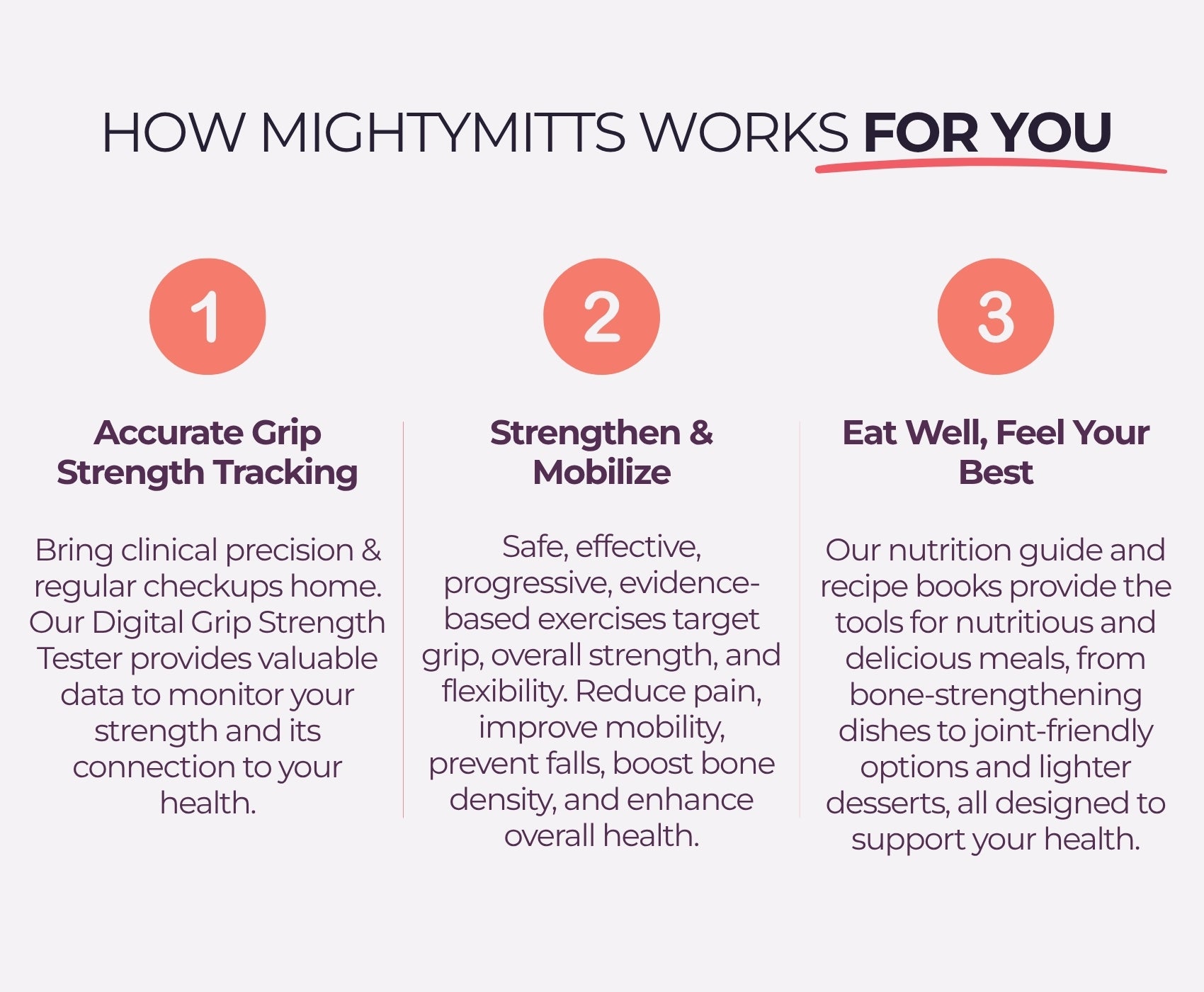GRIP STRENGTH: YOUR HEALTH IN YOUR HANDS
A Heads-Up for Heart Health
Spotting Falls Early
Preventing Fall-Related Challenges
Warning for Diabetes
Seeing Frailty Coming
A Clue to Longevity
| Women | |||||||
|---|---|---|---|---|---|---|---|
| Study/ Source |
Country | 50-54 Average |
55-59 Average |
60-64 Average |
65-69 Average |
70-74 Average |
75+ Average |
| PURE Study | 17 Countries | 25.5 kg | 21.8 kg | 23.1 kg | 24.2 kg | 19.2 kg | 20.5 kg |
| UK Biobank | United Kingdom | 26.1 kg | 24.8 kg | 23.7 kg | 22.4 kg | 21.1 kg | 19.8 kg |
| NHANES | United States | 54.23 lbs | 51.15 lbs | 47.84 lbs | 44.75 lbs | 41.45 lbs | 36.16 lbs |
| Men | |||||||
| Study/ Source |
Country | 50-54 Average |
55-59 Average |
60-64 Average |
65-69 Average |
70-74 Average |
75+ Average |
| PURE Study | 44.2 kg | 42.5 kg | 40.8 kg | 38.5 kg | 36.2 kg | 33.8 kg | |
| UK Biobank | 44.8 kg | 43.2 kg | 41.5 kg | 39.2 kg | 37.1 kg | 34.5 kg | |
| NHANES 2011–2014 | 90.17 lbs | 85.32 lbs | 80.25 lbs | 75.40 lbs | 70.77 lbs | 63.05 lbs | |
Important Medical Disclaimer: Grip strength is a predictor, not a diagnostic tool. It indicates likelihood or risk propensity for health conditions over time, but is not a diagnostic test itself. A "low risk" assessment doesn't rule out existing conditions — definitive diagnosis requires clinical and laboratory testing by healthcare professionals.
| Health Outcome | Women | Men |
|---|---|---|
| Fall Risk | <16kg | <26 kg |
| Cardiovascular Disease* | <16kg | <26 kg |
| Osteoporosis** | <16kg | <27 kg |
| Sarcopenia (Muscle Weakness) | <16kg | <27 kg |
Aley et al. (2014) Grip strength norms in women https://pmc.ncbi.nlm.nih.gov/articles/PMC8035217
Study on muscle weakness and cardiovascular risk https://www.sciencedirect.com/science/article/abs/pii/S0828282X21006619
Grip strength and osteoporosis risk over time https://pmc.ncbi.nlm.nih.gov/articles/PMC9980561
Cut-off points for grip strength in healthcare settings https://pmc.ncbi.nlm.nih.gov/articles/PMC10573963
* For general weakness associated with cardiovascular disease (CVD)
** For low muscle strength, based on EWGSOP2 study guidelines
And remember every 1kg improvement in your grip strength reduces the 10 year risk of cardiovascular diseases by 1.76 times. The Lancet
Benefits You Can Feel: Why Grip Strength Training Matters
Disclaimer: The information provided here is for general knowledge and informational purposes only, and does not constitute medical advice. It is essential to consult with a qualified healthcare professional for any health concerns or before making any decisions related to your health or treatment.
References & Works Cited
The insights provided on this page are supported by research in peer-reviewed scientific literature and findings from reputable health institutions.
- Hand grip strength as a proposed new vital sign of health: a narrative review of evidences, accessed on May 6, 2025, https://pmc.ncbi.nlm.nih.gov/articles/PMC10777545/
- How Weak Grip Strength Plays a Role in Aging - Cleveland Clinic Newsroom, accessed on May 6, 2025, https://newsroom.clevelandclinic.org/2023/03/28/how-weak-grip-strength-plays-a-role-in-aging
- How Well Will You Age? Check Your Grip Strength | TIME, accessed on May 6, 2025, https://time.com/7281402/grip-strength-longevity/
- What Your Grip Strength Means for Your Overall Health — and Exercises To Improve It, accessed on May 6, 2025, https://health.clevelandclinic.org/grip-strength
- THE IMPORTANCE OF GRIP STRENGTH AS WE AGE - Mya Care, accessed on May 6, 2025, https://myacare.com/blog/the-importance-of-grip-strength-as-we-age
- Handgrip strength as a predictor of functional, psychological and social health. A prospective population-based study among the oldest old - ResearchGate, https://www.researchgate.net/publication/41894490_Handgrip_strength_as_a_predictor_of_functional_psychological_and_social_health_A_prospective_population-based_study_among_the_oldest_old
- Hand-Grip Strength: Normative Reference Values and Equations for Individuals 18 to 85 Years of Age Residing in the United States | Journal of Orthopaedic & Sports Physical Therapy, accessed on May 6, 2025, https://www.jospt.org/doi/10.2519/jospt.2018.7851
- Rantanen, T., Volpato, S., Ferrucci, L., Heikkinen, E., Fried, L. P., Guralnik, J. M., ... & Group Health and Aging Study. (2000). Handgrip strength as a predictor of cause-specific mortality in older men. Journals of Gerontology Series A: Biological Sciences and Medical Sciences, 58(5), M495-M501.
- Syddall, H. E., Aihie Sayer, A., Dennison, E. M., Martin, H. J., Barker, D. J. P., & Cooper, C. (2003). Grip strength as a predictor of functional limitations in older people. Journals of Gerontology Series A: Biological Sciences and Medical Sciences, 58(1), M55-M60.
- Llewellyn, D. J., Lang, I. A., & Manniche, C. (2010). Handgrip strength as a predictor of cognitive impairment: findings from the English Longitudinal Study of Ageing. Journals of Gerontology Series A: Biological Sciences and Medical Sciences, 65(2), 186-192.
- Newman, A. B., Kupelian, V., Visser, M., Simonsick, E. M., Goodpaster, B. H., Nevitt, M., ... & Harris, T. B. (2006). Strength, but not muscle mass, is associated with gait speed in older adults. Journals of Gerontology Series A: Biological Sciences and Medical Sciences, 61(1), 72-78.

